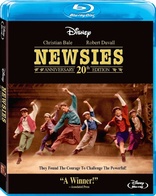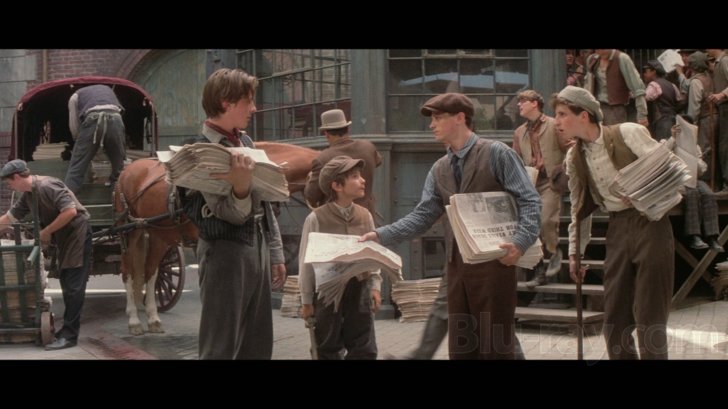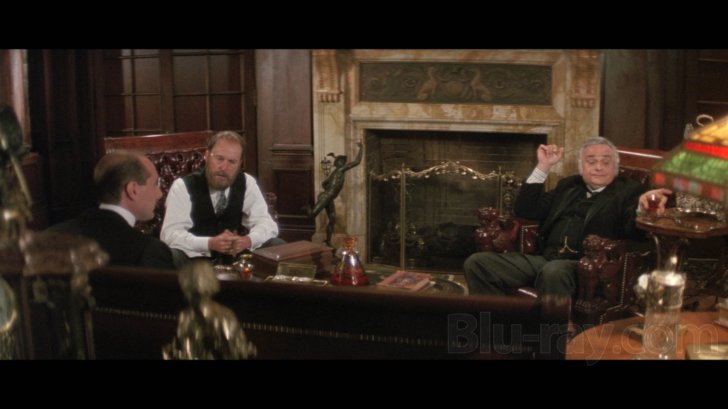Newsies Blu-ray Movie
HomeNewsies Blu-ray Movie 
20th Anniversary EditionDisney / Buena Vista | 1992 | 121 min | Rated PG | Jun 19, 2012

Movie rating
6.6 | / 10 |
Blu-ray rating
| Users | 4.0 | |
| Reviewer | 3.5 | |
| Overall | 3.6 |
Overview
Newsies (1992)
July, 1899: When Joseph Pulitzer raises the distribution price one-tenth of a cent per paper, ten cents per hundred, the newsboys, poor enough already, are outraged. Inspired by the strike put on by the trolley workers, Jack "Cowboy" Kelly organizes a newsboys' strike. With David Jacobs as the brains of the new union, and Jack as the voice, the weak and oppressed band together and challenge the powerful.
Starring: Christian Bale, David Moscow, Luke Edwards, Max Casella, Gabriel DamonDirector: Kenny Ortega
| Family | Uncertain |
| Musical | Uncertain |
| Drama | Uncertain |
Specifications
Video
Video codec: MPEG-4 AVC
Video resolution: 1080p
Aspect ratio: 2.34:1
Original aspect ratio: 2.39:1
Audio
English: DTS-HD Master Audio 5.1
Spanish: Dolby Digital 2.0
Subtitles
English SDH, French, Spanish
Discs
50GB Blu-ray Disc
Single disc (1 BD)
Playback
Region free
Review
Rating summary
| Movie | 3.5 | |
| Video | 3.5 | |
| Audio | 3.5 | |
| Extras | 3.5 | |
| Overall | 3.5 |
Newsies Blu-ray Movie Review
Extra! Extra! Flop Defies Critics, Becomes Hit!
Reviewed by Michael Reuben June 26, 2012Newsies' history as a film is as unlikely as that of its titular heroes. The biggest live action flop in Disney's history (at the time), it steadily built a devoted following on home video until it not only recouped its costs, but also spawned a hit stage musical that is currently filling the house on Broadway (and, like most successful musicals, can look forward to a profitable national tour). Like the determined newsboys for whom hawking papers is a matter of basic survival, Newsies won't take "no" for an answer. It was writers Bob Tzudiker and Noni White who came up with the idea of transforming the 1899 newsboy strike into a movie featuring "newsies" who sang and danced, and it was producer Michael Finnell who persuaded Disney to greenlight the project. Tzudiker and White were just getting started as writers (they would later work on The Hunchback of Notre Dame and Tarzan, among others), but Finnell was a veteran of such oddball fare as the Gremlins films and Innerspace. In its original concept, the film was supposed to be a drama, and no one seems to recall just when it became a musical. Certainly it was before Kenny Ortega was hired to direct, since Ortega was a veteran choreographer, whose resumé included such hits as Dirty Dancing and Ferris Bueller's Day Off. Newsies marked his debut as a feature director. To write songs, Finnell recruited the award-winning team of Alan Menken and Howard Ashman, whose soundtracks for Beauty and the Beast and The Little Mermaid deserve much of the credit for reviving the fortunes of Disney's animation department. When Ashman had to drop out due to the AIDS-related illness that would ultimately claim his life, he was replaced by Jack Feldman. Newsies' initial failure at the box office can be seen as a matter of timing. Its style was a throwback to an earlier era of movie musicals with all the artificiality of backlot decor, stylized choreography and the directness with which characters burst into song. The film's eventual success among an ever-expanding cult of loyalists is a tribute to the skill with which director Ortega and his cast and crew implemented that style, so that, for anyone who chooses to enter into the spirit of the thing, the film works at multiple levels. Star Christian Bale, who was a teenager when he made the film, has been quoted as follows: "You say something bad about Newsies, and you have an awful lot of people to answer to."

Newsies has almost too much plot. Several storylines overlap and interweave to the point where the film just barely manages to contain all of them. The overarching storyline concerns the effort by publisher Joe Pulitzer (Robert Duvall, in a performance that teeters right at the edge of ethnic caricature) to squeeze even more profit out of his successful newspaper, the New York World. Pulitzer's underling, Jonathan (Mark Lowenthal), recognizes that they can't extract more profit from customers by raising the price, but they can charge more to their distributors. Another senior executive, Seitz (Charles Cioff), counsels against this maneuver, but Pulitzer loves the idea. This was the era before newsstands and home delivery. The principal mode of distribution for newspaper publishers in New York City, including Pulitzer and his chief rival, William Randolph Hearst, are "newsies"—independent paperboys, all of them poor, many of them orphans, who line up every day (several times a day, if there are multiple editions), and buy papers to flog to customers from the distribution manager, Weasel (Michael Lerner). At Jonathan's suggestion, Pulitzer has Weasel raise the price charged to newsies by a tenth of a cent per paper. Now Pulitzer has his bigger profit, but the kids who were barely scraping by have to figure out how to sell even more papers just to stay even. The result is a strike by the newsies, and a standoff between a mob of "have not" teenagers and the city's richest and most powerful tycoon. Newsies' second plotline is the personal odyssey of Jack Kelly (Christian Bale), the organizer of the strike. Jack is a classic American hero: brash, self-made and also something of an outlaw. It turns out he's on the run, having escaped from a reform school run by a corrupt warden, Snyder (Kevin Tighe). But Jack is also the yearning soul of Newsies, and half an hour into the film Alan Menken gives him what has come to be known as the "I want" song that occurs in all Disney musicals since Ariel sang "Part of That World" in The Little Mermaid. Here the song is called "Santa Fe", which is where Jack longs to go, for the wide open spaces and the romance of the Old West. At the moment, though, Jack has to stay and lead the newsies, especially in difficult tasks like venturing into the scary wilds of Brooklyn to negotiate an alliance with Spot Conlon (Gabriel Damon), the short but intimidating leader of the town's toughest newsie gang. The third plotline concerns David Jacobs (David Morrow, who was the younger version of Tom Hanks in Big) and his little brother, Les (Luke Edwards), who have just started as newsies to help support their family, because their father (Jeffrey DeMunn) was laid off after an on-the-job injury. Jack takes them on as apprentices for purely mercenary reasons: Les has an angelic face that's a great marketing tool. Through David's eyes, because he's fresh to the scene, we get the least romantic perspective on a newsie's life, as he watches Jack and others struggling to make a living with no one to look out for them. Everyone else, including colorful characters like Racetrack (Max Casella), Crutchy (Marty Belafsky), Boots (Arvie Lowe Jr.) and Mush (Aaron Lohr), just takes the newsie's daily grind as normal life. It's also David who shows Jack what it's like to be part of a family. Of special interest to Jack, when David and Les bring him home to dinner, is their sister, Sarah (Ele Keats). Two additional characters weave in and out of the proceedings. One is a chipper lady named Medda Larkson, the Swedish Meadowlark, who owns a vaudeville house and performs there nightly. She's a friend to the newsies and to Jack in particular, always willing to shelter him from the authorities. Under different circumstances, one could imagine Medda being edited out of the film, but she's played by Ann-Margret—and when you have Ann-Margret in your musical, those scenes stay in the picture. The other key character is a reporter for the New York Sun named Denton (Bill Pullman), a former war correspondent who knows bravery when he sees it. Denton is instrumental in getting wider attention for the newsies' battle with Pulitzer. Eventually the story reaches all the way to the state capital in Albany. With so many characters and so much plot, it's a credit to director Ortega (and to editor William Reynolds, a two-time Oscar winner for The Sting and The Sound of Music) that Newsies manages to hang together, keep driving forward and even accommodate elaborately choreographed production numbers, the likes of which have rarely been seen since (and certainly not without the kind of slam-bang editing that leaves you wondering whether the dancers actually performed their moves). One of the reasons the film did better on home video than on the big screen may be that the smaller screen camouflaged the fact, which was inescapable on the big screen (and also on Blu-ray), that these musical extravaganzas are playing out on backlots and soundstages. Despite extensive historical research by the production team, Newsies doesn't have a single set that feels like a real place. It's a stylized, artificial world, done like an old Hollywood musical. By 1992, audiences were no longer comfortable with that style, except in animation, and arguably that hasn't changed today. It will be interesting to see how Newsies plays to new viewers in this Blu-ray edition, which effectively recreates the original experience in a manner that hasn't been possible until now.
Newsies Blu-ray Movie, Video Quality 

Newsies was the last feature film shot by the late Andrew Laszlo, a veteran cinematographer with a varied resumé that included Streets of Fire and The Warriors for Walter Hill, the original Rambo film, First Blood, and the fifth Star Trek film, The Final Frontier. Laszlo had worked in television, but he didn't compose or shoot for it when making a feature film. This is especially crucial for a film like Newsies, where scene after scene involves large groups of people, often in motion. The image on Disney's 1080p, AVC-encoded Blu-ray for Newsies presents some interesting issues. It's a detailed image, even though it doesn't have the crisp edges that eyes conditioned by digital photography have come to expect. If you don't go in looking for hard-edged "pop", but focus instead on the details of faces, costumes and decor, especially in long shots, it quickly becomes evident that the Blu-ray effectively reproduces the elaborate production design and the multitude of youthful cast members. The palette of Newsies is muted and dominated by the browns of street life, but in contrasting environments (Pulitzer's office or Medda's theater) brighter and more saturated hues appear, and the transfer brings them out effectively. Deep blacks are rarely in evidence, but this appears to be by design; no part of the frame is ever completely dark. Several posters on the Blu-ray.com forum have complained that parts of the film are too grainy. My own reaction was the opposite: I found large portions to be suspiciously "clean". I've spent some time reexamining portions of the film and have reached the following conclusions:
- Newsies has not been subjected to what people like to call "DNR". Let me repeat that with emphasis: Anyone citing this review for the proposition that Newsies has been "DNR'd" fails the reading comprehension test.
- Film grain is still visible throughout Newsies, but you often have to look closely to see it. Its visibility has been reduced as much as possible, consistent with a philosophy that seems to be gaining in major studios to minimize the appearance of visible film grain in Blu-ray transfers. (Sony is the notable exception.) The goal seems to be to make films from the analog era more closely resemble films from the brave new world of digital photography, digital projection and digital intermediates, because that's the look contemporary audiences have come to expect.
- The software available to post facilities has progressed to the point where the detail represented by film grain can be adequately translated to video without stripping it away. This is yet another reason (aside from imprecise usage) why "DNR" is no longer a relevant term. Post facilities no longer strip away grain as noise; they translate it into something that appears stable on video. (For a shining example, see Aliens.)
- Even with a first-rate "translation" of film grain to video, there are some scenes in Newsies—almost always in low-light conditions—where the grain is heavier. The granular texture of the translated image is therefore more obvious. But never does the image shimmer or vibrate the way an image typically described as "grainy" would.
Newsies Blu-ray Movie, Audio Quality 

The film's Dolby stereo surround mix is presented in DTS-HD MA 5.1, and the remix is conservative, using the discrete format to open up and clarify the vocals and instrumentation of the songs and otherwise leaving well enough alone. The dialogue is clear, in spite of (or maybe because of) the exaggerated accents and the aggressive period slang. One can readily understand why fans lobbied Disney to stage Newsies as a musical, because the actors already seem to be delivering much of their dialogue as if from a stage. (In fact, the book was entirely rewritten for the musical.) The original studio recordings of the songs are well-served by the discrete 5.1 format, as is the interstitial underscore by J.A.C. Redford.
Newsies Blu-ray Movie, Special Features and Extras 

- Commentary with Director and Co-Choreographer Kenny Ortega, Producer Michael Finnell, Writers Bob Tzudiker and Noni White and Co-Choreographer Peggy Holmes: Recorded in 2002, the former collaborators share fond memories of working with their young cast members and swap stories of the careers the cast went on to enjoy. The desire for a stage musical is a recurring theme (and now a reality).
- Newsies, Newsies, See All About It (SD; 1.33:1; 21:44): This made-for-TV promotional piece hosted by Max Cassella, Aaron Lohr and Arvie Lowe Jr. is the kind of slick but classy featurette that Disney was making long before Criterion set up shop. It contains interviews, rehearsal footage and on-set encounters, and generally provides an excellent overview of the making of the film.
- Newsies: The Inside Story (SD; 1.33:1; 19:28): In effect, this featurette functions as a continuation of "See All About It", but without the youthful hosts. It includes comments from major department heads (production design, costume, cinematography) about their respective contributions, as well as additional interviews with cast members and the director.
- The Strike! The True Story (SD; 1.33:1; 18:54): A select group of knowledgeable commentators provide historical context and detailed background for the events that inspired the film. Participants include: producer Finnell; screenwriters Tzudiker and White; historian Vincent DiGirolajo; David Nasaw, author of Children of the City; Susan Campbell Bartoletti, author of Kids on Strike; and Nancy Whitelaw, author of Makers of the Media, Joseph Putlitzer.
- Storyboard-to-Screen Comparison (with Optional Commentary by Production Designer William Sandell) (SD; 1.33:1; 6:12): Storyboards and scenes from the film fade in and out of each other. Sandell offers general observations and memories about the process.
- Trailers (SD; 1.33:1)
- #1 (2:07)
- #2 (1:43)
- Sing-Along Feature: The option is available from the subtitle menu and provides subtitles solely for the songs.
- Bonus Previews: At startup the disc plays a preview for The Odd Life of Timothy Green and an anti-smoking PSA. These can be skipped with the chapter forward or top menu buttons, but, unlike most Disney Blu-rays, there is no separate "Bonus Previews" item once the disc loads.
Newsies Blu-ray Movie, Overall Score and Recommendation 

This Blu-ray is an easy choice for a Newsies fan. The film has never looked this good, and Disney is unlikely to revisit it any time in the near future. For someone new to the film, I recommend renting first. It is very much a "love it or hate it" kind of classic. Feel free not to like it, but just remember Christian Bale's warning not to say anything bad about it. Remember—he's Batman.
Similar titles
Similar titles you might also like

Annie
2014

The Muppets Take Manhattan 4K
1984

The Cheetah Girls: One World
2008

An American Girl: Isabelle Dances Into the Spotlight
2014

Wonder
2017

The Wiz
1978

Bedknobs and Broomsticks
Special Edition
1971

Pete's Dragon
35th Anniversary Edition
1977

The Nutcracker
1993

The Muppets
2011

Willy Wonka & the Chocolate Factory 4K
1971

Chitty Chitty Bang Bang
1968

Annie
30th Anniversary Edition
1982

Fantasia 2000
1999

Mary Poppins
50th Anniversary Edition
1964

Fiddler on the Roof
1971

The Wizard of Oz
75th Anniversary Edition | w/ 2009 Video Transfer
1939

The Sound of Music 4K
60th Anniversary
1965

The Princess and the Frog 4K
Ultimate Collector's Edition
2009

The Music Man
2003